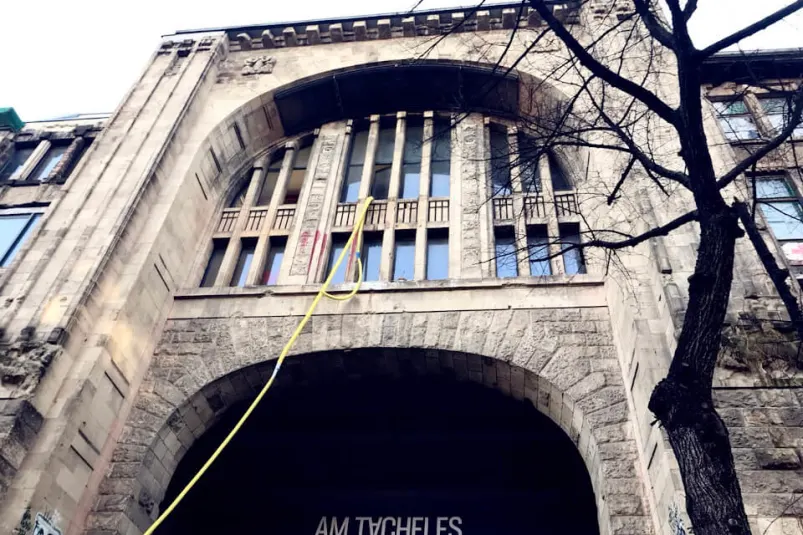Tacheles: Emblematic place and most famous Squat in Berlin

"How long is now?" was the inscription on the front of the building. The Tacheles, a dominant figure of Berlin's alternative culture, is now counting down the hours in the middle of the rubble and waiting for its new occupants... Department store, exhibition space, Nazi prisons and then squatting, let's look back at the highlights of this not-to-be-missed place in Berlin.
It all started in 1908
Built in 1908, the building extended from Friedrichstraße to Oranienburger Straße, a passageway connected the two streets. The five-storey building was constructed of reinforced concrete and had a large dome, with the facade supported by the concrete structure. There were several small shops on both sides of the covered passageway. The building is considered to be a typical example of early modern architecture, although it displays aspects of classical and Gothic architecture.
Commercial areas and technical house
Soon after the construction was completed, due to its airy configuration, the space was transformed into a commercial area, first accommodating several small shops and later a department store until 1914. Sold just before the First World War, the building was modified and a large cellar known as Tresorraum was built. In 1928, the AEG (Allgemeine Elektricitäts-Gesellschaft) used the hall as an exhibition and consulting area for its customers - the building was then called "Haus der Technik".
Nazi offices and prison
A few years later, with the rise to power of the radical movements, the NSDAP party took possession of the premises. In 1941, the Deutsche Arbeitsfront became the owner of the building and made it the central office of the SS. Some work was carried out: the glass parts of the roof were removed so that prisoners could be kept there. One of the cellars was flooded for a long time after the Battle of Berlin.
Under the GDR
As the government of East Berlin did not have the funds to renovate this war-damaged (but not totally destroyed) building, the building has disintegrated considerably over time. However, the fact that it was literally falling into ruin did not prevent various tradesmen and craftsmen from settling there "temporarily" - there was an art school, a technical school for international trade and economics, offices and even a cinema!
In 1958, the Camera Cinema on the Friedrichstraße side of the building had to leave the premises due to the worsening condition of the building. The presentation room was disused, but later reopened as the Oranienburger Tor Lichtspiele. During the reconstruction work, the facade of the building is partially transformed. The roof is also rebuilt. The entrance of the building then takes its present form. Finally, the site became a simple warehouse for building materials. The very last structure still standing was to be demolished in April 1990. This could very well have happened, if artists had not taken possession of the premises.
Germany's most famous squat
On February 13, 1990, two months before the planned destruction, the Künstlerinitative Tacheles group (an initiative of Tacheles artists) occupied the building and saved it. After a fierce struggle, these artists had it listed as a historic site - this was not officially recognized until 1992.
Renamed "Tacheles" meaning "outspokenness" in Yiddish, the building is painted in bright colours and a large courtyard behind the building houses numerous sculptures made of rubble, debris and other objects. For more than 20 years, the building hosted artists from all over the world. Although under constant pressure from the government to close it down, Tacheles had become the place to be for artists and the curious who came to visit the place and its countless graffiti, or to have a drink at the bar at the top of the building with an incredible view of Berlin.
Closing the squat in 2012
The last artists evacuated Tacheles in 2012 and the building has been inaccessible to the public ever since. You can only see the empty building from the outside - the garden at the back of the building is still open to the public and houses a permanent exhibition of metal sculptures as well as workshops for painters and sculptors.
What will become of Tacheles?
On September 26, 2014, the German Jagdfield Group, which specializes in luxury real estate and has owned Tacheles since 1998, will sell the building to the American fund Perella Weinberg Partners for 150 million euros. The new owner plans to renovate the buildings and install apartments, shops and cultural activities.

Raphaëlle Radermecker
Author
With a curious personality and a passion for well-chosen words, writing and discovery are my two passions. Berlin intrigues and fascinates me, with its cultural and artistic richness, its modernity and its ability to constantly renew itself.